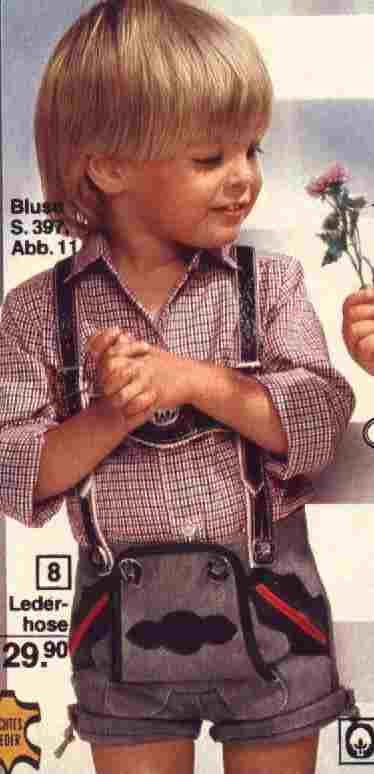s.jpg)
Figure 1.--Older German boys in the 1950s wore lederhosen as casual clothes--much as boys now wear jeans. |

|
HBC still has incomplete information on lederhosen as boys wear. They appear to have been primarily a garment for men and older boys. This had changed by the 1910s when some younger boys began wearing them. They wre probably nore common, however, for older boys through the 1930s. HBC is unsure, however, just how common they were among younger boys. Quite a number of younger boys appear to have worn them by the 1930s. After World War II lederhosden were very common for younger boys. Available advertising literature shows many ads for younger boys' lederhosen available in the 1970s. Older boys, except for folk costumes, however, stopped wearing lederhosen at this time--preferring jeans that were sweeping Europe at the time.
HBC's chronolgical information on German Lederhosen wear is still incomplete. We have, however, begun to collect information. Lederhosen have neen worn by a wide range of German boys, including both very young boys and teenagers. The conventions have, however, changed over time. We do not yet fully understand those conventions in the various historical eras. Our information is especially limited for the 19th century. We do have a better understanding of 20th century trends. We hope to better understand these trends as we develop more information over time.
Lederhosen appear to have been primarily a garment for men and older boys, primarily in Bavaria. HBC does not, however, have any early German photographs to comfirm this.
The 19th century pattern continued in the early 20th century. HBC has noted, however, some images from the early 20th century with younger boys also wearing lederhosen. They are largely novelty souvenir postcards. HBC is unsure to what extent younger German boys wore lederhosen. We do believe that the growth of youth groups, especilly the Wanervogel help to popularize lederhosen. The official Wandervogel uniform was cor shorts, but we believe that many boys wore ledehosen--especially because of the Wandervogel interest in folk culture. The lederhosen worn were still quite long during this period.
The conventions over wearing Lederhosen have changed by the 1910s when some younger boys began wearing them. They were probably nore common, however, for older boys through the 1930s. HBC is unsure, however, just how common they were among younger boys. Quite a number of younger boys appear to have worn them by the 1930s.
We note teenagers wearing Lederhosen after World War II in the 1940s and 50s. Sometimes the older boys did not wear the associated halters, especially boys outside of Bavaria. Lederhosden also became very common for younger boys. They also became less regionalized in Bavaria so we see boys all over Germany wearing Lederhosen. We are not sure if there were rehional variations affecting the ages of boys wearing Lederhosen. There seem to have been a major change in the 1960s when jeans became increasingly popular. Teenagers stopped wearing Lederhosen commonly, although they never disappeared. Available advertising literature from the 1970s shows many ads for younger boys' lederhosen. Older boys, except for folk costumes, however, stopped wearing lederhosen at this time--preferring jeans that were sweeping Europe at the time.
HBC plans to assess what age boys wore lederhosen. This effort is complicated by the fact that many of the available images archieved by HBC do not indicate the age or ages of the individuals pictured. We can, however, make some basic assessments of the age involved. The photographic record does illustrate the wide age ranges of German boys wearing Lederhosen. We note virtually every age group except infants wearing Lederhosen. They were commonly worn to school as well as for play and casual wear. Sime boys also used them for dressing up, probably mostly in Bavaria. There may have been age conventions associated withbthe various usages. These and other age conventions appear to have changed over time.
Navigate the Boys' Historical Clothing Web Site casual pages:
Navigate the Boys' Historical Clothing Web Site:Inter-war Years
Post-war era

Figure 2.--This German ad, probably from the 1970s, shows a younger boy wearing lederhosen.
Ages
HBC
[Return to the Main German lederhosen boyswear a page]
[Camp shorts]
[Clam diggers]
[Cord shorts]
[Jeans]
[Jump suits]
[Koveralls]
[Pinafore]
[Shortalls]
[Smocks]
[Soccer shorts]
[Return to Main short pants page]
[Introduction]
[Activities]
[Bibliographies]
[Biographies]
[Chronology]
[Clothing styles]
[Countries]
[Contributions]
[Literary]
[Images]
[Links]
[Registration]
[Boys' Clothing Home]

Created: March 4, 2001
Last updated: 9:50 PM 11/16/2008